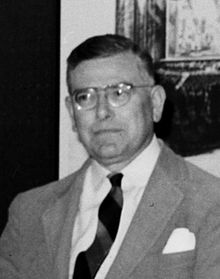
Paul Thiry (architect)
Paul Thiry | |
|---|---|
 | |
| Born | 1904 Nome, District of Alaska, U.S. |
| Died | 27 June 1993 (aged 88–89) |
| Alma mater | University of Washington College of Built Environments École des Beaux-Arts |
| Occupation | Architect |
Paul Thiry (1904–1993) was an American architect most active in Washington state, known as the father of architectural modernism in the Pacific Northwest. Thiry designed "some of the best period buildings around the state of Washington during the 1950, 60s and 70s."[1]

Life
Thiry was born in Nome, Alaska, of French parents. He was a 1928 graduate of the architecture school at the University of Washington and studied at the École des Beaux-Arts in France.[1] He traveled in Europe and met Le Corbusier, before returning to Seattle in 1935.[2] He also traveled to and worked in Japan.[3]

Thiry designed his own house upon his return [2] but had few commissions in the 1930s. Those he built "showed a clear understanding of the European International Style in his use of spare, geometric forms, clean lines, and new building technologies."[4]


Thiry came to national attention in 1937 with a cement-based stuccoed residence for a manager at Portland Cement, Frank J. Barrett. The innovative house was published in The Modern House in America in 1940: the garage and house formed two rectangles, with a "smooth, undecorated exterior", its doors and windows flush with the surface. Steel window frames were painted blue-green, and glass-brick was used around the entry and along the walls of the partly sunken living room.[5]

Thiry served as supervising architect for the Seattle World's Fair,[5] responsible for the overall plan and coordinating the work of contributors like John Graham Jr. (for the Space Needle), Minoru Yamasaki, and the landscape architect Lawrence Halprin. Thiry's own designs for the fair included the Washington State Pavilion, which later became the KeyArena and is today the Climate Pledge Arena.

Thiry has been compared to other modernists in the Northwest such as Pietro Belluschi (1899–1994) and John Yeon (1910–1994).[4] Thiry is quoted as having said that "Buildings should be good neighbors."[6] He is credited with being "instrumental" to introducing International Style architecture in Seattle.[2]

Lewis and Clark College


Thiry designed the Agnes Flanagan Chapel, the Aubrey Watzek Library, and the Biology-Psychology Building[7] at Lewis and Clark College in Portland, Oregon.

The Flanagan chapel is "a creatively designed 16-sided structure" with an 85-rank Casavant Frères organ and seating for 600 people. According to the Lewis and Clark website the building "serves as a meeting place for lectures, musical performances, and religious services. The entry is a bridge flanked by Northwest Coast Indian-style statues depicting the four evangelists (Matthew, Mark, Luke, and John) created by the artist Lelooska, Don Morse Smith.[8][9]

Projects
- Apartment building, 2717 Franklin Avenue E, Seattle, WA (1929)[3]
- Paul Thiry residence, 330 35th Avenue E, Seattle, WA (1935–1936)[3]
- Frank J. Barrett residence (1937)
- Nichols House, 1600 Boston Terrace E, Seattle, WA (1939)[3]
- Thiry architectural office, 800 Columbia Street, Seattle, WA (1946)
- Electrical Engineering Building, University of Washington, Seattle, WA (1948)[3]
- Museum of History and Industry (MOHAI) (1952) at 2700 24th Avenue East in Seattle, Washington [10][11]
- Northeast Branch Library, 6801 35th Avenue NE, Seattle, WA (1954)[3]
- Regents Hill (originally "New Women's Dormitory"), Washington State University, Pullman, Washington (1952)
- Frye Art Museum (1952) at 704 Terry Avenue in Seattle (later remodeled and expanded)[5]
- Washington State Library, Olympia, Washington, 1959
- Western Washington University campus plan, Bellingham, WA (1959-1963)[3]
- U.S. Embassy Residence, Santiago, Chile, 1961
- Nalley's Fine Food pavilion (1961) [12]
- supervising architect for Seattle's Century 21 Exposition, along with his own design for the Washington State Pavilion, now the Climate Pledge Arena (1961)
- St. Demetrios Greek Orthodox Church, Seattle, WA (1964)
- Delta Upsilon chapter house, Washington Chapter, Seattle, Washington (1967).
- Watzek Library (1968) and the Agnes Flanagan Chapel (1969) at Lewis and Clark College in Portland, Oregon[13][14]
- concrete sanctuary addition to the North Slope section, Christ Episcopal Church, Tacoma, Washington (1970)
- consulting architect for the Libby Dam project, Libby, Montana (1975)
Bibliography
- Churches and Temples with Richard Bennett and Henry Kamphoefner Rheinhold Publishing 1953[15]
References
- ^ a b NORTH SLOPE HISTORIC DISTRICT; PIERCE COUNTY, WASHINGTON United States Department of the Interior National Park Service NATIONAL REGISTER OF HISTORIC PLACES. OMB No. 1024-0018 Section 8, 11 pages
- ^ a b c Caroline T. Swope Classic houses of Seattle: high style to vernacular, 1870-1950
- ^ a b c d e f g Woodbridge, Sally B. and Roger Montgomery (1980). A Guide to Architecture in Washington State. Seattle: University of Washington Press.
- ^ a b Jan Goggans, Aaron DiFranco [1] page 12 The Pacific region
- ^ a b c Walt Crowley, Paul Dorpat National Trust Guide, Seattle: America's guide for architecture and history travelers Preservation Press Series, John Wiley and Sons, 1998 ISBN 0-471-18044-0, ISBN 978-0-471-18044-9
- ^ The Theory of Architecture: Concepts Themes & Practices By Paul-Alan Johnson page 226
- ^ "Campus Buildings". www.lclark.edu.
- ^ "Pendant". National Museum of the American Indian. Retrieved 3 September 2024.
- ^ Virtual tour Archived 2009-10-29 at the Wayback Machine Lewis and Clark College website
- ^ Museum of History and Industry (Seattle, Washington) photograph University of Oregon Libraries
- ^ "Museum of History and Industry — MOHAI". mohai.org. Archived from the original on September 9, 2006.
- ^ "The Nalley's Fine Food pavilion was a plastic form shell pneumatically applied on a frame of reinforcing rods and metal lathe. The exterior of the pavilion was constructed without a straight line or sharp angle. The unique oval contained a theater which showed movies of the great Pacific Northwest. In the lobby of the building were displays of the food products from Nalley's Tacoma-based company. Image courtesy University of Washington Libraries, Special Collections Division." Vintage Seattle
- ^ Watzek Library photograph Photo ID mdr07676 University of Oregon Libraries
- ^ Flanagan, Agnes, Chapel (Portland, Oregon) photograph Flanagan, Agnes, Chapel (Portland, Oregon) University of Oregon Libraries
- ^ Mark Allen Torgerson An architecture of immanence: architecture for worship and ministry today Calvin Institute of Christian Worship liturgical studies series Edition illustrated Wm. B. Eerdmans Publishing, 2007 ISBN 0-8028-3209-1, ISBN 978-0-8028-3209-2, 313 pages, page 112
External links
- Biography at HistoryLink
- University of Oregon Libraries photographs of the Agnes Flanagan Chapel and Watzek Library at Lewis and Clark College and the Museum of History and Industry (Seattle, Washington)
- 1904 births
- 1993 deaths
- Fellows of the American Institute of Architects
- Modernist architects from the United States
- American ecclesiastical architects
- Architects from Seattle
- University of Washington College of Built Environments alumni
- Century 21 Exposition
- National Academy of Design members
- 20th-century American architects
- People from Nome, Alaska
- American alumni of the École des Beaux-Arts
See what we do next...
OR
By submitting your email or phone number, you're giving mschf permission to send you email and/or recurring marketing texts. Data rates may apply. Text stop to cancel, help for help.
Success: You're subscribed now !
